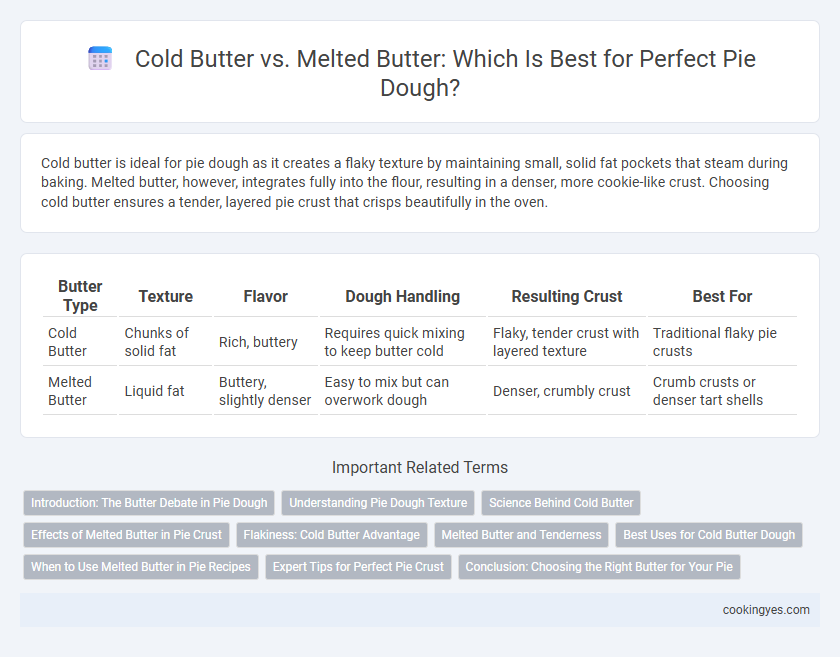Cold butter is ideal for pie dough as it creates a flaky texture by maintaining small, solid fat pockets that steam during baking. Melted butter, however, integrates fully into the flour, resulting in a denser, more cookie-like crust. Choosing cold butter ensures a tender, layered pie crust that crisps beautifully in the oven.
Table of Comparison
| Butter Type | Texture | Flavor | Dough Handling | Resulting Crust | Best For |
|---|---|---|---|---|---|
| Cold Butter | Chunks of solid fat | Rich, buttery | Requires quick mixing to keep butter cold | Flaky, tender crust with layered texture | Traditional flaky pie crusts |
| Melted Butter | Liquid fat | Buttery, slightly denser | Easy to mix but can overwork dough | Denser, crumbly crust | Crumb crusts or denser tart shells |
Introduction: The Butter Debate in Pie Dough
Choosing between cold butter and melted butter significantly impacts pie dough texture and structure. Cold butter creates flaky, tender layers by releasing steam during baking, essential for classic pie crusts. Melted butter, conversely, produces denser, less flaky dough, often resulting in a crumbly texture unsuitable for traditional pies.
Understanding Pie Dough Texture
Cold butter in pie dough creates flaky, tender layers by remaining solid and melting slowly during baking, which traps steam and forms pockets in the crust. Melted butter results in a denser, less flaky texture due to the fat being fully incorporated into the dough, preventing steam formation and layer separation. For optimal pie dough texture, using cold butter is essential to achieve a light, crisp crust with distinct layers.
Science Behind Cold Butter
Cold butter in pie dough creates a flaky texture because its solid state prevents the fat from fully blending with flour, allowing small pockets of butter to remain. During baking, these pockets melt and release steam, which puffs up the dough layers and forms a tender, airy crust. The science behind using cold butter is crucial for maximizing flakiness and ensuring a light, crumbly pie crust.
Effects of Melted Butter in Pie Crust
Melted butter in pie dough creates a denser, less flaky crust because the fats are fully incorporated and do not form distinct layers. This results in a tender, crumbly texture rather than the traditional light, crisp flakiness achieved with cold butter. Using melted butter can produce a richer flavor but sacrifices the structural integrity and characteristic crispness of classic pie crusts.
Flakiness: Cold Butter Advantage
Cold butter creates pockets of steam during baking, which results in a flakier pie crust with distinct layers. Melted butter, by contrast, blends uniformly into the dough, reducing the formation of these flaky layers. For optimal pie crust flakiness, incorporating cold butter chips or cubes maintains texture and enhances the overall mouthfeel.
Melted Butter and Tenderness
Melted butter in pie dough contributes to a more tender and crumbly crust by allowing the fat to evenly coat the flour particles, reducing gluten formation. This results in a softer texture compared to cold butter, which creates flakiness by leaving distinct layers. Using melted butter can enhance the pie's overall tenderness while maintaining a delicate structure.
Best Uses for Cold Butter Dough
Cold butter is essential for creating flaky pie dough because it helps form pockets of steam during baking, resulting in a tender and layered crust. It is best suited for recipes requiring puffiness and a crumbly texture, such as fruit pies and quiches. Keeping butter cold maintains the dough's structure, preventing it from becoming tough or greasy.
When to Use Melted Butter in Pie Recipes
Melted butter is ideal for pie dough recipes that require a tender, crumbly texture, such as shortbread crusts or graham cracker crusts. It blends more uniformly with dry ingredients, creating a cohesive dough that is easy to press into baking pans without the need for rolling. Using melted butter is preferable in no-bake or chilled pie recipes, where a firm, buttery crust sets properly without overworking the dough.
Expert Tips for Perfect Pie Crust
Using cold butter in pie dough creates a flaky, tender crust by allowing small butter pockets to remain intact, which melt during baking and produce steam. Melted butter tends to result in a denser, less flaky texture due to the uniform fat distribution. Experts recommend chilling the dough after mixing cold butter to ensure optimal flakiness and avoid overworking the gluten, which can toughen the crust.
Conclusion: Choosing the Right Butter for Your Pie
Cold butter creates a flakier pie crust by maintaining solid fat pockets that steam during baking, producing layers. Melted butter yields a denser, more tender crust due to the uniform fat distribution throughout the dough. For traditional flaky pies, cold butter is optimal, while melted butter suits crumbly or shortbread-style crusts.
Cold Butter vs Melted Butter for Pie Dough Infographic

 cookingyes.com
cookingyes.com